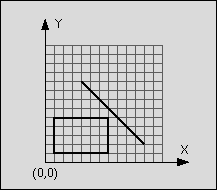poj 1410 Intersection
Intersection
Time Limit: 1000MS
Memory Limit: 10000K
Total Submissions: 7166
Accepted: 1836
Description
You are to write a program that has to decide whether a given line segment intersects a given rectangle.
An example:
line: start point: (4,9)
end point: (11,2)
rectangle: left-top: (1,5)
right-bottom: (7,1) 
Figure 1: Line segment does not intersect rectangle
The line is said to intersect the rectangle if the line and the rectangle have at least one point in common. The rectangle consists of four straight lines and the area in between. Although all input values are integer numbers, valid intersection points do not have to lay on the integer grid.
Input
The input consists of n test cases. The first line of the input file contains the number n. Each following line contains one test case of the format:
xstart ystart xend yend xleft ytop xright ybottom
where (xstart, ystart) is the start and (xend, yend) the end point of the line and (xleft, ytop) the top left and (xright, ybottom) the bottom right corner of the rectangle. The eight numbers are separated by a blank. The terms top left and bottom right do not imply any ordering of coordinates.
Output
For each test case in the input file, the output file should contain a line consisting either of the letter "T" if the line segment intersects the rectangle or the letter "F" if the line segment does not intersect the rectangle.
Sample Input
1 4 9 11 2 1 5 7 1
Sample Output
F
#include <iostream>
#include <cstdio>
using namespace std;
#define Min(x,y) (x<y?x:y)
#define Max(x,y) (x<y?y:x)
struct Node
{
int x,y;
};
int CrossMutiply(Node& p1,Node& p2,Node& p3)//叉积
{
return (p2.x-p1.x)*(p3.y-p1.y)-(p2.y-p1.y)*(p3.x-p1.x);
}
int PointMutiply(Node& p1,Node& p2,Node& p3)//点积
{
return (p2.x-p1.x)*(p3.x-p1.x)+(p2.y-p1.y)*(p3.y-p1.y);
}
bool Segments_Intersect(Node& p1_start,Node& p1_end,Node& p2_start,Node& p2_end)//判断两线段是否相交
{
int d1=CrossMutiply(p1_start,p1_end,p2_start);
int d2=CrossMutiply(p1_start,p1_end,p2_end);
int d3=CrossMutiply(p2_start,p2_end,p1_start);
int d4=CrossMutiply(p2_start,p2_end,p1_end);
if((d1*d2<0)&&(d3*d4<0)) return true;
else if(d1==0&&PointMutiply(p2_start,p1_start,p1_end)<=0) return true;
else if(d2==0&&PointMutiply(p2_end,p1_start,p1_end)<=0) return true;
else if(d3==0&&PointMutiply(p1_start,p2_start,p2_end)<=0) return true;
else if(d4==0&&PointMutiply(p1_end,p2_start,p2_end)<=0) return true;
else return false;
}
int main()
{
int n;
Node rectangle[5],pStart,pEnd;
bool flag;
scanf("%d",&n);
while(n--)
{
scanf("%d%d%d%d%d%d%d%d",&pStart.x,&pStart.y,&pEnd.x,&pEnd.y,&rectangle[0].x,&rectangle[0].y,&rectangle[2].x,&rectangle[2].y);
int min_x=Min(rectangle[0].x,rectangle[2].x);
int min_y=Min(rectangle[0].y,rectangle[2].y);
int max_x=Max(rectangle[0].x,rectangle[2].x);
int max_y=Max(rectangle[0].y,rectangle[2].y);
if(pStart.x>=min_x&&pStart.y>=min_y&&pStart.x<=max_x&&pStart.y<=max_y)
{
if(pEnd.x>=min_x&&pEnd.y>=min_y&&pEnd.x<=max_x&&pEnd.y<=max_y)
{
printf("T\n");
continue;
}
}
rectangle[4]=rectangle[0];
rectangle[1].y=rectangle[0].y;
rectangle[1].x=rectangle[2].x;
rectangle[3].y=rectangle[2].y;
rectangle[3].x=rectangle[0].x;
flag=false;
for(int i=0;i<4;i++)
{
if(Segments_Intersect(pStart,pEnd,rectangle[i],rectangle[i+1]))
{
flag=true;
break;
}
}
if(flag) printf("T\n");
else printf("F\n");
}
return 0;
}


